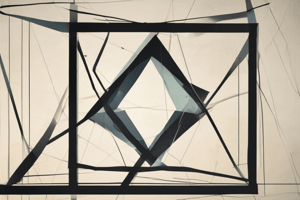Podcast
Questions and Answers
What is the formula for finding the area of a parallelogram?
What is the formula for finding the area of a parallelogram?
- $\frac{1}{2}bh$
- $bh$ (correct)
- $bh\tan{\alpha}$
- $bh\cos{\alpha}$
Which property is consistent across all types of quadrilaterals?
Which property is consistent across all types of quadrilaterals?
- All sides are equal
- Opposite sides are parallel
- At least one pair of consecutive angles add up to $90^ ext{o}$
- All inner angles sum to $360^ ext{o}$ (correct)
In a cyclic quadrilateral, what property do the diagonals possess?
In a cyclic quadrilateral, what property do the diagonals possess?
- They are parallel
- They are perpendicular to the sides
- They bisect each other
- They are orthogonal (correct)
What is a common feature of rectangles and squares?
What is a common feature of rectangles and squares?
Which type of quadrilateral has opposite sides that are parallel and of equal length?
Which type of quadrilateral has opposite sides that are parallel and of equal length?
What distinguishes trapezoids from parallelograms?
What distinguishes trapezoids from parallelograms?
What is a diagonal in a polygon?
What is a diagonal in a polygon?
How many diagonals can a quadrilateral have?
How many diagonals can a quadrilateral have?
What is the formula to find the perimeter of a quadrilateral?
What is the formula to find the perimeter of a quadrilateral?
What is the formula to calculate the area of a rectangle?
What is the formula to calculate the area of a rectangle?
In a square, what is the relationship between the side length and the area?
In a square, what is the relationship between the side length and the area?
What does the formula \(
d = \sqrt{a^2 + b^2} \), represent?
What does the formula \( d = \sqrt{a^2 + b^2} \), represent?
Flashcards are hidden until you start studying
Study Notes
Quadrilaterals: Exploring Diagonals, Perimeters, Areas, Properties, and Types
Quadrilaterals are flat shapes comprising four sides and four vertices connected by edges. As you delve into their intricacies, uncovering details about diagonal lengths, measurements of borders, interior spaces, distinct characteristics, and classifications will deepen your understanding of these foundational geometry concepts.
Diagonals of Quadrilaterals
A diagonal is a line segment drawn between nonadjacent vertices of a polygon, crossing its interior. In quadrilaterals specifically, there may be up to two diagonals, depending upon whether they intersect inside the shape or lie outside it. For example, consider a rectangle with adjacent side lengths (a) and (b), and diagonal length (d): [ d = \sqrt{a^2 + b^2} ].
Perimeter of Quadrilaterals
The perimeter, also known as the boundary or circumference, refers to the total distance around a closed figure's outline. To find the perimeter ((P)) of any quadrilateral, simply add together the lengths of all its four sides: [ P = s_1 + s_2 + s_3 + s_4] where each (s) represents one side length.
Area of Quadrilaterals
In order to calculate the area of most common quadrilaterals, we can employ well-known formulas:
For a rectangle: [ A = lw ], where (l) stands for length and (w) signifies width.
For a square: [ A = s^2 ], where (s) denotes side length.
For a parallelogram: let (bh) represent base times height; (A=bh\sin{\alpha}), where angle (\alpha) measures from either base to the opposite parallel side.
For more complex figures such as trapezoids, rhombi, kites, etc., which are technically not pure quadrilaterals because they do not have opposite pairs of parallel lines, area calculations require the application of additional concepts such as Heron's formula, Law of Cosines, and other algebraic manipulations.
Properties of Quadrilaterals
While each type of quadrilateral exhibits unique traits, general properties remain consistent across all forms:
- All inner angles must sum to (360^\circ).
- At least one pair of consecutive angles must add up to (180^\circ).
- Any cyclic quadrilateral possesses orthogonal diagonals. A cyclic quadrilateral is any quadrilateral within whose sides circles may be circumscribed.
- If a quadrilateral has an orthogonal diagonal, then another exists as well, and both bisect the quadrilateral's area.
Types of Quadrilaterals
Four basic types of quadrilaterals exist:
- Rectangles: Four right angles, opposite sides congruent.
- Squares: All sides equal, four right angles.
- Parallelograms: Opposite sides are parallel and of equal length.
- Trapeziums (or trapezoids): One pair of opposing sides are parallel.
Other specialized cases:
- Rhomboi (rhombuses): All sides congruent, but not necessarily four right angles.
- Kites: Two sets of congruent sides, but not a parallelogram nor a rectangle.
- Trapezahedra: With three faces forming a plane trapezoid.
- Hexagons (similar, but six sides instead of four).
Understanding the fundamentals and subtle differences among these diverse categories offers insight into geometry and its applications. While this introduction provides essential knowledge, further study can lead to even deeper insights into various intriguing aspects of quadrilaterals.
Studying That Suits You
Use AI to generate personalized quizzes and flashcards to suit your learning preferences.




